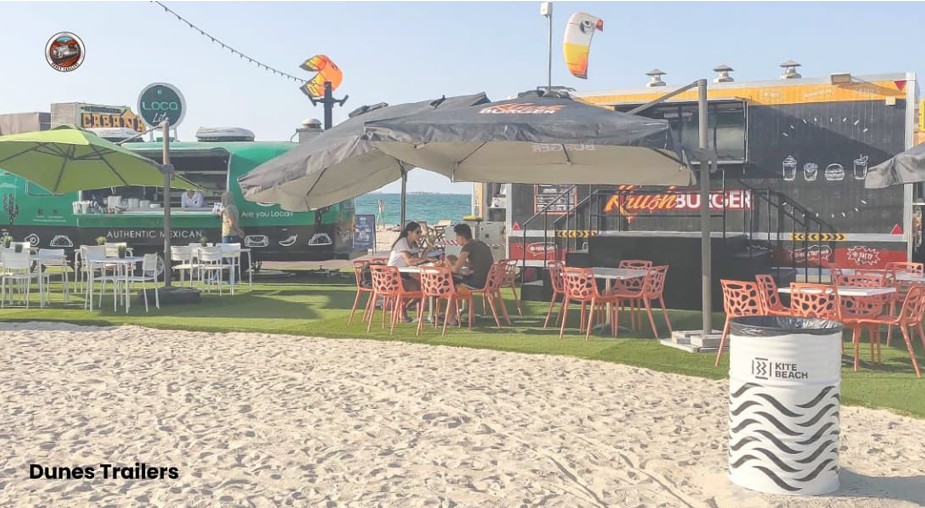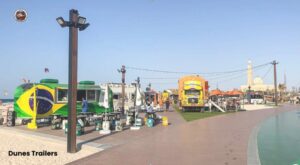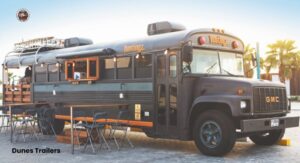
Food trucks have grown from a trend into a permanent part of the UAE’s dining culture. With the right location, they attract long queues of families, tourists, and late-night foodies. It’s important to know how to set up, what audience to expect, and how to stay compliant in a country with strict regulations.
This guide explores the best locations across Dubai, Abu Dhabi, Sharjah, Ajman, and Ras Al Khaimah. It also breaks down the essential permit process so operators can expand without surprises.
Why Choosing the Right Location Makes All the Difference
Location determines visibility, sales, and even the type of menu that works best. Family-friendly beachfronts draw fitness enthusiasts, while design districts attract creative food concepts. In contrast, highway food truck parks such as Last Exit attract road-trippers looking for quick, filling meals.
Outdoor events are popular in the UAE from October to April, when the weather is pleasant. During hotter months, food trucks often shift towards malls, promenades, and night-time service. Operators who align their presence with this seasonal rhythm usually achieve higher returns.
At Kite Beach, families dominate evenings, while tourists fill JBR – The Walk during afternoons. Understanding these micro-patterns allows a food truck to prepare the right menu, staff numbers, and promotional strategy.
Dubai: Must-Hit Food Truck Hotspots
Dubai remains the most competitive and rewarding city for food trucks. Its diverse zones—from beaches to creative districts—offer a mix of consistent footfall and event-driven surges.
Beachfront & Family Zones
Kite Beach has become almost synonymous with food trucks. The mix of fitness enthusiasts, families, and students ensures a broad audience, especially on weekends. Here, trucks like SALT have demonstrated how a simple concept with strong branding can thrive.
JBR – The Walk and the surrounding Dubai Marina area provide a very different crowd. Tourists dominate here, and they look for convenient, photo-worthy meals they can enjoy while walking the promenade. Items like rolled ice cream, gourmet fries, or global street snacks perform especially well.
Burj Park and Downtown Dubai also see seasonal setups. Trucks that trade here during festivals or New Year’s Eve events often enjoy some of the city’s most lucrative evenings.
Destination Truck Parks
Last Exit is a unique concept developed to celebrate the food truck movement. These hubs are located along the E11 highway, Al Qudra, Al Khawaneej, and Al Ain Road. Operators benefit from infrastructure like parking, seating, and visibility, but need strong comfort-food menus that work well on the move.
Dubai Design District (d3) offers another type of opportunity. For trucks experimenting with bold fusion menus or launching new concepts aimed at a trend-aware audience, d3 is ideal.
Mall-Fringe & Mixed-Use Areas
The Dubai Mall promenade attracts enormous tourist numbers during cooler months. It’s essential to offer signature, photo-friendly items to international visitors who may never return.
City Walk is a pedestrian-friendly mixed-use district where young professionals and families spend evenings. Pop-ups tied to events often succeed here, blending casual comfort with premium presentation.
Pop-Up & Seasonal Circuits
Event circuits add another layer to Dubai’s food truck culture. Dubai Food Festival, TruckersDXB, and seasonal winter markets bring together curated groups of trucks, exposing operators to new audiences. The events require advanced applications through Dubai Festivals & Retail Establishment (DFRE).
Abu Dhabi: Emerging & Established Food Truck Zones

Abu Dhabi’s food truck scene is newer than Dubai’s, but it is expanding quickly with government-supported zones and lifestyle developments.
Iconic Outdoor Destinations
Hudayriyat Island – Marsana has become a central hub for trucks. The beachfront boardwalk fills with families, cyclists, and young crowds during evenings. Wind and humidity must be considered, but the volume and night-time trading opportunities are unmatched.
Marsa Mina, located near the cruise terminal, combines family entertainment with dining. Colorful, child-friendly menus and shareable platters perform particularly well in this setting.
City & Corniche Strips
The Abu Dhabi Corniche remains a classic promenade destination. Tourists and locals stroll here daily, making compact, easy-to-carry foods a smart fit. Residential zones like Khalifa City and Al Shamkha Park are also popular for community-based food trucks, especially during weekends when families seek nearby dining options.
Yas Bay & Event-Driven Pop-Ups
With its concerts, motorsport events, and resort hotels, Yas Bay is a lucrative but irregular opportunity. Trucks that align with event calendars can capture large, diverse crowds, particularly during major race weekends or live shows.
Sharjah, Ajman & RAK: Regional Favorites Worth Exploring
While Dubai and Abu Dhabi dominate discussions, northern emirates present growing opportunities with less saturation.
Sharjah Food Truck Scenes
Al Majaz Waterfront is Sharjah’s answer to Dubai’s family destinations. Evening crowds grow during festivals, and food trucks offering a mix of affordable comfort food and signature desserts find success here.
Al Qasba and Al Khan Beach are leisure areas where locals prefer traditional, familiar snacks at accessible price points. Trucks trading here should adapt menus to reflect community tastes.
Ajman Highlights
Ajman Corniche offers consistent local traffic. Trucks here tend to do well with quick-serve staples such as shawarma, karak tea, and affordable desserts.
For a more upscale audience, The Spot – Al Zorah provides a planned food truck park that attracts residents from nearby resorts and communities. Trucks that focus on polished branding and premium offerings stand out in this environment.
Ras Al Khaimah Hotspots
Al Marjan Island is a rising destination for food trucks thanks to its cluster of resorts and family visitors. SALT and Origins already operate here, proving the model works.
Nearby, Mina Al Arab – Lagoon Stop has emerged as a dedicated food truck corridor. Well-lit setups, event tie-ins, and partnerships with lifestyle brands make it a reliable venue for trucks looking to test menus outside Dubai.
Regulatory Checklist: Getting Permits Across the Emirates

Operating in the UAE requires careful compliance. Each emirate has its own process, but the main checkpoints are consistent.
Dubai: Step-by-Step
- Trade Licence from DET/DED with food truck activity.
- RTA Approval for vehicle modification and branding.
- Dubai Municipality Food Control
- FoodWatch Registration and an approved HACCP Plan.
- Location Permits for fixed zones or event venues.
- Insurance, waste management plan, and fire safety compliance.
Abu Dhabi: At a Glance
- ADAFSA approval for food safety.
- TAMM Portal application for food truck permits.
- Venue-specific permissions for zones like Marsana or Yas Bay.
- Health, safety, and food-handler training records.
Sharjah, Ajman, RAK
- Municipality permits for each emirate.
- Event-specific approvals for festivals and seasonal markets.
- Compliance with HACCP or equivalent food safety frameworks.
- Branding and signage approvals aligned with local regulations.
Operational Insights & Optimization Strategies
Success isn’t only about permits and parking. Daily operations, timing, and branding choices matter just as much.
- Timing & Seasonality: Trade hard during cooler months. In summer, focus on night-time service and shaded zones.
- Menu Fit: Offer comfort food at family beaches, trendy fusion at design districts, and hearty meals at highway hubs.
- Rotation Strategy: Hold anchor locations (e.g., Last Exit, Marsana) and supplement with festivals or seasonal pop-ups.
- Marketing: Use geo-tags, event hashtags, and live updates to keep customers informed. Partnerships with gyms, schools, or community pages help maintain local visibility.
Sample Location Strategy Table
| Location | Footfall Type | Ideal Time | Permit Focus |
| Kite Beach | Families, fitness crowd | Evenings & weekends | DET/DED + DM + HACCP + FoodWatch |
| Last Exit (all hubs) | Road-trippers, families | Weekends, road peaks | DET/DED + RTA vehicle & branding |
| JBR – The Walk | Tourists, shoppers | Afternoons to nights | Location permit + municipal approvals |
| Marsana – Hudayriyat | Beachgoers, night visitors | Sunset to late night | ADAFSA + TAMM + venue permit |
| Al Majaz Waterfront | Family & festival traffic | Evenings, event days | Sharjah Municipality + event permit |
| Al Marjan Island | Resorts & staycationers | Late afternoon–night | RAK Municipality + waste & fire compliance |
Final Thoughts & Takeaways
The UAE offers unmatched opportunities for food trucks, but success depends on precision. Choose locations that match your concept, align with seasonality, and stay fully compliant with local regulations.
Secure a balance of anchor zones, event participation, and rotating appearances to build brand recognition. Food trucks here are more than mobile kitchens—they are destinations in themselves.
Dunes Trailers will help you With smart planning and the right permits, your truck can become a landmark on the UAE’s culinary map.
FAQ
Q: What’s the quickest way to get started in Dubai?
Secure your trade licence, apply for RTA vehicle approval, and prepare HACCP documents in advance. Having FoodWatch access before the build-out saves time.
Q: Can I operate in multiple locations at once?
Yes, if permits cover each venue. Many operators rotate trucks weekly, updating social media to keep customers informed.
Q: Are late-night hours allowed at beaches?
Yes, zones like Hudayriyat Marsana and Kite Beach support extended hours, but lighting, safety, and noise rules apply.
Q: Do I need HACCP certification in every emirate?
Dubai mandates HACCP and FoodWatch, while Abu Dhabi relies on ADAFSA systems. Other emirates require food safety documentation that often mirrors HACCP standards.
Q: What documents do festivals usually request?
Trade licence, vehicle approval, insurance, staff health cards, and waste disposal plans are common requirements.






